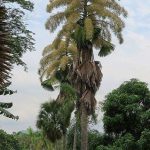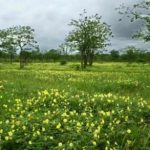TREE LIFE
March 2008
MASHONALAND CALENDAR
16 March: (3rd Sunday): Christon Bank. A return visit to an interesting place not far from town.
Directions: Take the Mazowe Road out of Harare turning right to Christon Bank about 22.5 km from Harare. Follow the tarred road right down past the ZRP Police Post (on your right) ignoring all the various turn-offs to right or left. Continue to the end of the tar (± 7 km) and park in the parking area on the right (the Botanical Reserve). As usual, we will meet at 9.30 a.m. in the car park.
MATABELELAND CALENDAR
Please contact Jean Wiley or Gill Short for details of the next Matabeleland function.
NOTICE OF ANNUAL GENERAL MEETING
Notice is hereby given that the 58th Annual General Meeting of the Tree Society of Zimbabwe will be held on Sunday, 18 May 2008 at 9.30 a.m. The venue is still to be confirmed and will be announced in a later Tree Life.
Any proposals/resolutions and nominations for office bearers should be forwarded to PO Box A723, Avondale, Harare by Monday 12 May if possible, although proposals and nominations will be accepted from the floor.
AGENDA
1. Notice convening the meeting
2. Apologies
3. Minutes of the 57th A.G.M.
4. Matters Arising
5. Chairman’s Report
6. Treasurer’s Report
7. Election of Committee Members
8. Any Other Business
SUBSCRIPTIONS ARE DUE NOW FOR 2008/09
Subscriptions for the year ending 31 March 2009 become payable on 1 April 2008.
The amounts are as follows.
Email $6 million
Printed copy: collected $18 million
Printed copy: posted $30 million
Although we give in the table the rates for preparing and sending printed copies we would rather send out Tree Life by email because it is easier and cheaper, and there is far less of a risk of cost overruns.
Once again, I must emphasise strongly that we do not want to lose members as a result of these increases. Each year a number of members pay more than the norm so that the excess goes anonymously to support members who may be having financial difficulties. So, please do not be proud; talk to Terry or me.
We would also very much prefer to receive the subscriptions in cash.
Payment may be made in the following ways:
1. at the Mukuvisi Woodland wildlife shop;
2. to the Treasurer, Terry Fallon, at 285 Samora Machel Avenue (tel: 778789);
3. to me, Mark Hyde, at Pentact, 3rd floor ZTA House, 95, Nelson Mandela Avenue, Harare (tel: 708758).
4. To any other Committee member.
However, if paying by cheque, please make it out to CABS and on the reverse ‘Pay to the account of the Tree Society’.
Mark Hyde
OUTING TO MT HAMPDEN, 18 NOVEMBER 2007
The outing was led by Meg Coates-Palgrave and based at the home of Jean Simon, at Mt Hampden, north of Harare. The area lies in the flat headwaters of the Gwebi River. Most of the original miombo woodland has been cut out and is now under cultivation. The area we visited on the southern slope of Mt Hampden hill still retains a fair cover of old miombo woodland dominated by Brachystegia spiciformis. Mt Hampden hill is an inselberg of banded ironstone. Soils are red sandy loams. Thank you, Meg and Jean, for an interesting day.
As always with any outing led by Meg, it was an intensive learning experience. “Pick a leaf,” says Meg. For most of my adult life, I have looked at trees and leaves, but never really looked at the leaves themselves. I think that most of us are like that, but when you eventually “pick a leaf” and study it, a whole new world of interesting shapes and detail is revealed. Is it simple leaf? Is it a compound leaf? Is it once-compound, once-pinnate–or is it twice compound, twice pinnate? The word “pinnate” is derived from the Latin word “pinna”, meaning feather. Think of the pinions of a soaring eagle! Look at the shape. Feel the texture. What colour is it? Hold it up to the light and look through it. Crush it and smell it.
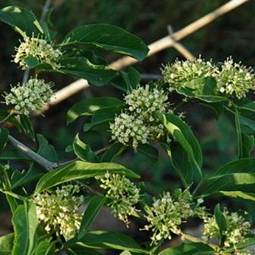
Pavetta gardeniifolia. Photo:Wikipedia
Take Pavetta gardeniifolia, commonly called the stink gardenia. Its specific name gardeniifolia means “gardenia-like leaves” because of the shape of its light green, simple obovate leaves. Crush the leaf and smell the pungent scent. Hold a leaf up to the light and see the black bacterial nodules characteristic of this species. A distinctive feature of an Ochna schweinfurthiana leaf is the shape and colour of the midrib. Feel the keeled shape of the upper and lower surfaces of the leaf’s midrib. Feel how the upper leaf surface is ribbed and has a rough leathery texture. Run your fingers along the finely serrated leaf margin, which feels like a saw blade. See how the light yellowy-green midrib contrasts with the bright shiny green upper surface.
An alphabetical list of the 29 species recorded:
Acacia sieberiana; Celtis africana; Brachystegia spiciformis; Combretum molle; Cussonia arborea; Diospyros lycioides; Dombeya rotundifolia; Ekebergia benguelensis; Erythrina abyssinica; Euclea natalensis subsp. acutifolia; Ficus burkei; Ficus sur; Gymnosporia senegalensis; Khaya anthotheca; Lannea edulis; Lannea discolor; Ochna puberula; Ochna schweinfurthiana; Parinari curatellifolia; Pavetta gardeniifolia; Phoenix reclinata; Pittosporum viridiflorum; Psorospermum febrifugum; Rhus longipes; Senna singueana; Tapiphyllum velutinum; Uapaca kirkiana; Vangueriopsis lanciflora; and Vernonia myriantha.
-Bernard Beekes
INVASIVE ALIEN PLANTS IN SOUTHERN AFRICA
In this next in the series on invasive aliens, researcher Lesley Henderson discusses several families of invasive alien plant species that occur in southern Africa.
–Ed.
Terminology and Overview of Species
Southern Africa has a long history of problem plants that have been variously called ‘weeds’, ‘pest plants’, ‘plant invaders’, ‘invasive plants’, ‘bush encroachers’, ‘naturalised exotics or aliens’, ‘environmental weeds’, ‘transformers’, and others. The terms have been used to describe both indigenous plants (native, belonging to southern Africa) and non-indigenous plants (exotic, alien, introduced to southern Africa).
History
Non-indigenous or alien plants were first introduced to southern Africa between one and two thousand years ago. These were plants mainly of central and northern African origin and were associated with human activities. Most plants from other continents were introduced to southern Africa by European colonists from 1652 onwards. The first control campaign against an alien plant in South Africa was initiated in 1860 against spiny cocklebur, Xanthium spinosum.
Terminology
Much confusion exists in the English-language literature on plant invasions concerning the terms ‘naturalised’ and ‘invasive’ and their associated concepts. Richardson et al. (2000) have provided definitions that they hope will permit widespread application and acceptance, and these are given here in part.
Introduction implies that a plant or its propagule has overcome, through human agency, a major geographical barrier (intercontinental or infra-continental – usually >100 km).
Alien plants are plant taxa in a given area, the presence of which there is due to intentional or accidental introduction as a result of human activity.
Casual alien plants do not form self-replacing populations and rely on repeated introductions for their persistence.
Naturalised plants are alien plants that reproduce consistently and sustain populations over many life cycles without direct intervention by humans.
Weeds are plants (not necessarily alien) that grow where they are not wanted and that usually have detectable economic or environmental effects. Many indigenous pioneering species are weeds of disturbed sites such as roadsides, overgrazed land and waste places. Alien weeds occur in the same disturbed sites and are also common in cultivated lands, planted pastures and lawns.
Environmental weeds are alien plants that invade natural vegetation, usually adversely affecting native biodiversity and ecosystem functioning.
Invasive plants, plant invaders or invader plants, usually refer to naturalised alien plants that have the ability to produce offspring, often in very large numbers, at considerable distances from parent plants. The most aggressive invaders can spread far from parent plants and cover large areas. The most damaging invaders may be termed transformers as they can change the character, condition, form, or nature of ecosystems over substantial areas. In southern Africa the term ‘invasive’ has sometimes been applied to indigenous species where distribution or density has increased in response to human-induced changes in the environment. Indigenous woody species that invade overgrazed land are referred to as bush encroachers.
Invasive Plant Lists
The most comprehensive listing of weeds and invasive plants in southern Africa was published by Wells et al. (1986) in their Catalogue of problem plants of southern Africa. The catalogue lists 1,653 taxa (species and varieties or subspecies) of indigenous and alien plants. The catalogue includes a list of 984 ‘naturalized exotics’, which contains 789 plant taxa that are generally agreed to be both alien and naturalised, a further 91 taxa where naturalisation is uncertain, and 104 taxa of uncertain origin. The great majority of these plants are herbaceous and invade sites of severe human disturbance. They are classified as ruderal weeds (=of waste places) and agrestal weeds (=of cultivated lands). Approximately 10% are classified as flora weeds—alien invasive species competing with the indigenous flora.
Arnold & De Wet (1993), Plants of southern Africa: names and distribution, lists 858 taxa of naturalised alien species that are catalogued in the Pretoria National Herbarium.
The next most comprehensive catalogue of naturalised alien species is probably that contained in the Southern African Plant Invaders Atlas (SAPIA) Database, which is managed by the author. The SAPIA database currently contains 500 species, of which 200 are not listed by Wells et al. (1986). Not all of these species have become truly naturalised; some are occasional garden escapees that require considerable disturbance to become established. However, they are all regarded as worthy of listing, as they could become the invaders of the future. All the species in the SAPIA database have been recorded in natural or disturbed sites, excluding cultivated lands.
Invasive Species
At least 1,000 alien plant species are known to be naturalised in South Africa. About 200 (20%) of these species are regarded as important environmental weeds invading natural or near-natural habitats. They represent 53 families and 113 genera. The following nine plant families contribute 61% of the species:
Fabaceae (legumes)
Asteraceae (daisies)
Myrtaceae (eucalyptus/myrtle family)
Solanaceae (potato family)
Cactaceae (cacti)
Pinaceae (pines)
Poaceae (grasses)
Rosaceae (rose family)
Convolvulaceae (bindweed family)
Acacia, with thirteen species, is the most important genus, followed by Eucalyptus and Pinus, with seven and eight species respectively.
Sixty-five per cent of the major environmental weeds are trees or shrubs, and 90% of species are perennials. Most species originate from South and Central America (38%), Europe and Asia (32%), and Australia (15%). Each major biome or vegetation type has a characteristic set of major invaders, some of which are virtually exclusive to that biome, for example, Hakea sericea (silky hakea) and Pinus pinaster (cluster pine) in fynbos, Chromolaena odorata (triffid weed) and Lantana camara (lantana) in savanna, and Pyracantha angustifolia (orange firethorn) in grassland. Some species are found in several biomes, for example, the cactus Opuntia ficus-indica (sweet prickly pear). Several very widespread invaders owe their extensive distribution to their spread along river systems; examples include Acacia mearnsii (black wattle) and Sesbania punicea (red sesbania).
Extent of Invasion
The extent of plant invasions is difficult to assess. There have been various surveys done, but comparing statistics is complicated by the variety of measures used. It appears that aquatic habitats are the most severely invaded, followed by watercourses, and – in South Africa – the winter-rainfall region. The summer-rainfall, subtropical coastal belt would be next, followed by the escarpment and the Northern Province.
Worst Offenders
Some of the most widespread invaders in South Africa include Acacia mearnsii, the black wattle, which is naturalised in some 21% of the region. Prosopis spp., known as prosopis or mesquite, have invaded some 19% of the total area. Acacia cyclops, red-eye or rooikrans, is present in some 8% of the total area. It stretches along almost the entire Cape coastline, a distance exceeding 2,000 km.
Lesley Henderson
-Source: SABONET News 6.2: 84
ARNOLD, T.H. & DE WET, B.C., (eds). 1993. Plants of southern Africa: names and distribution, Memoirs of the Botanical Survey of South Africa No. 62
RICHARDSON, D.M., PYŠEK, P., REJMANEK, M., BARBOUR, M.G., PANETTA, F.D. & WEST, C.J. 2000. Naturalization and invasion of alien plants: concepts and definitions. Diversity and Distributions 6, 93–107.
WELLS, M.J., BALSINHAS, A.A., JOFFE, H., ENGELBRECHT, V.M., HARDING, G. & STIRTON, C.H. 1986. Catalogue of problem plants of southern Africa. Memoirs of the Botanical Survey of South Africa No. 53.
???
INVADER-ANIMAL INTERACTIONS: THE CHOMOLAENA STORY
What do a reptile, an alien plant and sex have in common? The reptile referred to here is the Nile crocodile; the alien plant is Chromolaena; and sex? Well, reference here is to the sex ratios of hatchling crocodiles. But first a little more about the Nile crocodile and then about Chromolaena itself and the interaction between the two.
Crocodilians belong to the great group of archosaurs, also referred to as the ‘ruling reptiles’. Crocodiles and alligators are found between the latitudes of Cancer and Capricorn (23.5° north and south), in the rivers and lakes of South America, Africa, Asia and Australia. The Nile crocodile (Crocodylus niloticus), is one of three species inhabiting Africa and is widespread throughout the continent south of the Sahara.
Nile crocodiles have wide habitat preferences, reflecting their success and distribution as a species. They are present in a variety of wetland habitats, including rivers, lakes, swamps and brackish water, and are even found in coastal areas of west and southern Africa.
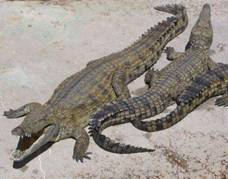
Nile crocodile, (Crocodylus niloticus) . Photo: Wikipedia
As we know, crocodilians are highly efficient predators. They have powerfully constructed armour-plated bodies, stout limbs, streamlined tails, impressive bony heads and extremely strong, tooth-studded jaws; every tooth in their jaws is adapted for catching and holding prey. Added to this is the fact that they are ‘opportunistic’ hunters – they will eat pretty much whatever comes their way.
A number of studies have revealed that the reproductive cycle of crocodilians is very complex and also the most advanced among all the reptiles. Crocodilians in the wild nest every two to three years. Sexual maturity is both size and age dependent, and unlike mammals and birds, the sex of those embryos is determined at the moment of fertilisation; the embryo within a newly laid crocodilian egg is without sex – sex determination depends entirely on the temperature at which the egg is incubated. Cooler nests produce more females and warmer nests produce more males, so a nest could produce an entire clutch of female hatchlings, male hatchlings, or a mixture of both. A difference of 0.5 – 1°C in incubation temperature results in markedly different sex ratios. Consequently, where the female digs her nest and when she lays her eggs have major effects on the sex ratio of her offspring.
The critical temperature varies among species but all crocodilians, whether they live in Himalayan mountain streams, tropical jungles or temperate swamps, incubate their eggs at temperatures close to 30°C. Exposure to temperatures below 27°C and above 34°C kills embryos of most species.
A number of surveys for Nile crocodiles have been conducted in recent years, and information on crocodile status is ‘average’. However, for 25 out of 39 African countries there is inadequate information. Hide-hunting in the mid-1900s at a time when the Nile crocodile was classified as vermin, caused dramatic declines in populations throughout most of its range, resulting in it being listed on Appendix 1 of CITES in 1975. However, protection by national laws and international regulations has resulted in a recovery in many parts of the species’ range. By 1985, due to the crocodile’s recovery, expanding human populations and the high value placed on crocodile skin, pressure to recommence exploitation induced CITES to introduce a quota scheme under which a limited number of wild crocodile skins could be exported annually.
The Nile crocodile, because it produces what is considered a ‘classic’ hide, is one of the most commercially utilized species of crocodilians. World trade numbered 80,000 skins annually in 1993, with the majority coming from crocodile ranching in Zimbabwe (54%) and South Africa (15%). Commercial utilization is now widespread and many successful management programmes have been established. However, there are still a number of factors threatening Nile crocodile populations throughout Africa, one being conflict with people. Man and crocodiles compete for suitable habitat and for certain food items such as fish.
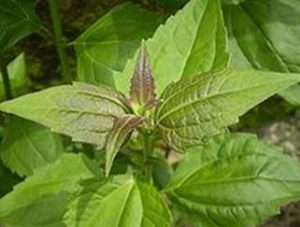
Chromolaena odorata. Photo: Wikipedia
We all too often hear how vital habitats for both fauna and flora are altered and destroyed by man. A particularly bad example is the accidental introduction of an alien plant – Chromolaena odorata (a perennial, scrambling shrub in the Aster family, also known by numerous common names: Siam weed, bitter bush, Christmas bush, Jack in the Bush, and Triffid weed) into South Africa that is invading crocodile nesting sites. [Triffid weeds were walking, man-eating plants in the science-fiction book, The Day of the Triffids, written by British author John Wyndham in the 1950s. The name was adopted for Chromolaena because of the plant’s monstrous, alien-invading characteristics! -Ed] Not only is the plant preventing crocodiles from nesting in some traditional nesting areas, but it is also casting dense shade on others, thereby reducing the incubation temperature and thus altering the sex ratio of the developing hatchlings. More female hatchlings resulting from the cooler incubation temperatures experienced could lead to eventual extirpation of the species from the nesting areas affected. Chromolaena is also reported to be spreading into Mozambique, Zimbabwe and Botswana – other countries with Nile crocodile populations – so the problem may very well be regional. Invasive alien species are now recognised by the International Union for the Conservation of Nature (IUCN) to be among the top four biggest threats to the maintenance of biological diversity on the planet.
Chromolaena is a herbaceous perennial native to the Neotropics. It occurs as both a shrub standing at least 3 metres tall in the open, and as a scrambler reaching a height of 10 metres among trees. It grows rapidly and produces massive quantities of small, light seeds – more than a million per plant – which are dispersed over long distances by wind, and also by humans, animals and water.
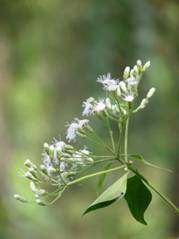
Chromolaena odorata flowers. Photo: Wikipedia
Stems reach 2 cm in diameter. The plants are maintained by a system of abundant, yellowish, fine lateral roots. Multiple sprouts arise from the root crown and lower stems. The individual branches are long with relatively few branches. Foliage occurs only on recent growth. The opposite, three-nerved leaves are deltoid to ovate-lanciolate, usually with a dentate margin and a long pointed tip. The leaves are aromatic when crushed. The inflorescences are corymbs of cylindrical heads located on the terminals of lateral branches. There are 15 to 25 tubular florets per head, white, lavender, pink, or blue in colour.
The plant thrives on disturbed land and readily invades crops, pastures and plantations. It tends to form dense thickets, which smother indigenous vegetation and increase the intensity of fire. In Africa there are two centres of invasion, each with a distinct form – or biotype – of Chromolaena. The West African form was introduced from an invasive population of Chromolaena in southeast Asia, while the morphologically different southern African form apparently originated from a northern Caribbean island, possibly Jamaica.
It occurs in most areas below 1000 m elevation from southern Florida to north-western Argentina, but it is not a problem in its place of origin. It is a plant of ‘secondary succession’ in that it invades clearings and persists until shaded out by the overgrowth of forest trees. In the New World, the species is controlled by a number of factors, including attack by native insects, other arthropods and diseases, together with competition from related plants. However, due to the absence of these species-specific factors, the plant has naturalized in parts of Africa and elsewhere, where it has become an incredibly successful exotic species and a noxious weed.
Chromolaena is incredibly fast growing, is quite difficult to detect, and is capable of vegetative reproduction (i.e., where a new plant can grow from a piece of root stock). It produces huge numbers of largely wind-dispersed seeds aided by their small brown parachutes, has a number of genetic strains, and has lots of close relatives. It also promotes fires and is fairly catholic in the habitats it can grow in. It is an invader of primarily the tropical and subtropical forested areas that harbour most of the world’s biodiversity, usually found in the less-developed countries that have some of the world’s most rapidly increasing human populations and concomitant increases in human pressure.
It is thought to have been mistakenly introduced to South Africa in seed-contaminated packing materials offloaded at Durban Harbour during World War II. By 1986, invasion of the species had reached alarming proportions in the entire KwaZulu-Natal coastal region. In the past two decades, it has spread within South Africa, as well as in Swaziland, Mozambique, Zimbabwe and Botswana. In South Africa, Chromolaena is primarily seen as a threat to conservation, but it also impacts on forestry, pastoral agriculture and other land uses.
The spread of Chromolaena has proceeded largely unchecked. Few private landowners have had the interest to clear Chromolaena in its early stages of invasion, or the resources to clear it at a later stage.
So what is being done about Chromolaena? The answer is plenty – but the big question is, are we doing it fast enough? According to the Agricultural Research Council (ARC) of South Africa, if Chromolaena is to be reduced to manageable levels in southern Africa, several actions must be taken. This includes the development of a coordinated clearance plan with increased awareness and funding, and the release of biological control agents – natural predators or parasites. With Chromolaena, this is tricky because we do not know for certain where the southern African species originated and it is therefore difficult to track down its natural predators. ARC’s biological control programme, in operation since 1988, has prioritised ten insect species for investigation, and several pathogens collected on Chromolaena plants in the Americas are also being examined for their potential as biocontrol agents. Much is happening in the way of biocontrol, but it is a slow, monotonous and expensive process.
In addition to all this vital research, much is also happening in the form of manual removal and poisoning of the aliens in South Africa by the ‘Working for Water’ programme (which began in 1995), a national programme for controlling the 750 tree species and 8000 other plant species that have been introduced into South Africa. This programme combines labour, mechanical, chemical, controlled fire and biological treatments. Australia has introduced a cost-sharing programme with land-owners to encourage eradication.
Although South Africa has not as yet found a satisfactory biocontrol agent, some other countries have been more successful. Chromolaena arrived in Ghana in the late 1960s and, by the 1980s, had covered almost 60% of the country’s land area. A staggering statistic! Its weed status was luckily very quickly realised and efforts involving biocontrol were made to control it, particularly through the use of a defoliating arctiid moth obtained from the University of Guam. The insect was released on Chromolaena plants in an experimental field around the research centre in 1989, and ten years later the insect had established itself as an effective natural enemy of Chromolaena in many parts of Ghana, where the land invasion area is now reduced to about 35%.
Not everyone sees Chromolaena as a problem weed. In Cameroon, local farmers aver that the weed increases soil fertility, and in Ghana it is said to have medicinal properties. The US Department of Agriculture reports that the plant has moderate food value for large mammals. For such reasons, and there are likely many more, it may be difficult to develop a coordinated clearance plan within Africa.
So whether it is crocodiles, plantation crops, forests or pristine conservation areas, Chromolaena is a serious threat worldwide and a concerted effort is required to help combat the spread of this species.
[Based on an article, supplemented from other sources, by Dr Alison Leslie that first appeared in Magnum Magazine, January 2001. Dr Leslie is an Aquatic Ecologist in the Department of Nature Conservation at the University of Stellenbosch, and a specialist in the ecology of crocodiles. See also S. Matthews & K. Brandt, Africa Invaded: The growing danger of invasive alien species, Global Invasive Species Programme 2004]
BULAWAYO’S HILLSIDE DAMS: UPDATE
Some of the email addresses for the Hillside Dams Project have had to be changed. The website is still www.hillsidedams.com, but Rob Burrett’s correct current email address is: estate@hillsidedams.com.


